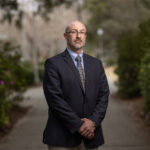UWF public health graduates serve in leadership roles in the field of U.S. Navy medicine

UWF has had many graduates who have served in the U.S. Navy and in the field of Navy medicine. Many graduates have gone on to become senior leaders within their respective fields occupying jobs from executive medicine, senior medical officers for operational platforms, as well as continuously supporting the rigorous operational environments in which the U.S. Navy operates.
Twelve UWF graduates who graduated between the years of 2017 to 2023 served aboard all 12 U.S. Navy aircraft carriers which include USS Nimitz (CVN-68), USS Dwight D. Eisenhower (CVN-69), USS Carl Vinson (CVN-70), USS Theodore Roosevelt (CVN-71), USS Abraham Lincoln (CVN-72), USS George Washington (CVN-73), USS John C. Stennis (CVN-74), USS Harry S. Truman (CVN-75), USS Ronald Reagan (CVN-76), USS George H.W. Bush (CVN-77), USS Gerald R. Ford (CVN-78) and USS John F. Kennedy (CVN-79).
CAPT Jon Elliot ’17 served for two years as senior medical officer aboard the USS Gerald R. Ford. “There was not a single day of my two year duty as a senior medical officer aboard the USS Gerald R. Ford that I did not draw upon training in public health through UWF,” Elliot said. “The competency I displayed in the multiple areas of public health made me a trusted advisor throughout the CVN leadership team, opening the door for greater discussions and progress toward a healthier and higher performing crew, more adaptable and able to complete the mission of the ship.”
Elliot said there is only one senior medical officer on the ship. That professional also serves as the Carrier Strike Group, known as CSG, surgeon when the strike group deploys. The CVN alone houses approximately 5,000 sailors. The CSG includes 8,000 to 10,000 sailors utilizing eight to 10 ships and an air wing of about 70 aircraft. Supervision of all things that impact the human element falls upon the CVN senior medical officer, from health care to basic life-sustaining elements such as food sanitation and operational hazard mitigation.
“As an experienced primary care physician, I was surprised at how much I needed fundamental training in public health to be effective in the role of CVN SMO,” Elliot said. “The public health needs of the CVN are formidable and require a diligent professional with a solid understanding of public health principles in order to adapt to the unique CVN environment and the unique needs of its crew. I felt well prepared for this role. The dedication of the UWF public health team to ensuring that this training is possible is nothing short of inspiring.”
For more information about UWF’s Department of Public Health, visit uwf.edu/mph.
“The views expressed herein are those of the authors or persons interviewed and do not necessarily reflect the official position of the Department of Defense or its components.”



